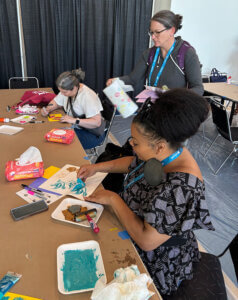
Participants at ISTELive 24 in Denver work together to create puppets as part of the Camp Creativity activation.
In the cover and CMP Series story in Convene’s May/June issue, we looked at the maker movement from a variety of angles within the context the events industry — from speaking to the founder of Maker Faires, which take place around the world to getting to the bottom of how Knoxville became Etsy’s first official U.S. “Maker City,” to workshops in Canada where groups create Indigenous crafts as a way to learn about their culture.
I recently read of a similar workshop that immerses participants in another culture. An initiative offered at the Grand Velas Riviera Nayarit in Puerto Vallarta, Mexico, gives guests at the all-inclusive resort the opportunity to paint brass corazon de milagritos (miracle hearts), in sessions guided by an artist who explains the history and meaning of milagritos. In traditional Mexican culture, people crafted miracle hearts in the hopes of receiving a miracle or divine intervention for health, safety, love, prosperity, or other personal needs.

During a printmaking workshop at ISTElive 24, said Megan McMahon of ITSE and ASCD, one participant commented, “This is so therapeutic.”
Stephanie Arnold, CMP, recently shared with Convene how her association has created a maker space at its annual event that speaks to the culture of its audience — educators. The spaces also serve to foster connections among attendees. Arnold, managing director for experience strategy and operations at ISTE (International Society for Technology in Education) and ASCD (Association for Supervision and Curriculum Development) told Convene via email that the concept was a “happy accident with an activation we started two years ago” at an ISTELive conference, which “has surprisingly turned into a low-key networking space.”
Since the two organizations (ASCD and ISTE, which merged in 2022), “are education-focused, we thought it would be great to highlight student/classroom art projects in a museum or gallery environment,” Arnold wrote. “In 2023, we hosted a Discovery Museum and modeled it a bit after an art museum but also like a children’s museum and had hands-on classes to make mosaics, crochet, or painting mini-robots. In 2024, we changed it to Camp Creativity — we were in Denver with an outdoors theme — where we offered printmaking and puppetry along with interactive art walls and the art displays.
“These quieter spaces that offer reflection as well as hands-on creation have given individuals who are either looking for a reprieve from the hectic environment of the conference or are more introverted, a place to connect with other individuals in a non-pressurized manner.”

The hands-on maker sessions at ITSELive offer participants a chance to network, reflect on sessions, and get away from the hustle of the conference, one organizer said.
“You are right on about hands-on making as a way that can deeply engage attendees,” Arnold’s colleague Megan McMahon wrote me, referring to our maker economy story. McMahon, who serves as the organization’s director, event learning initiatives, said the maker spaces at ISTELive “provide opportunities to reflect on sessions (while you are making), to rejuvenate energy (almost rest and relax from the high energy at conferences), and make connections with people while creating side by side.” During a printmaking workshop, she recalled, one participant commented, “This is so therapeutic.”
McMahon said that “meeting people while you are doing something is really low stakes.” It’s easy to start conversations, she said, “around what materials are you using — ‘How did you do that?’ ‘Where will you use this?’ etc.” It’s been interesting, she said, to see how much time participants want to devote to these activities. “We’ve had people stay for over two hours to make puppet theaters.”
Michelle Russell is editor in chief of Convene.
